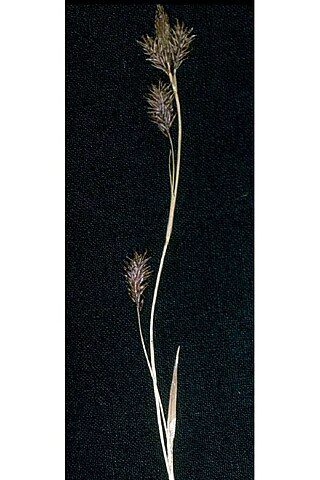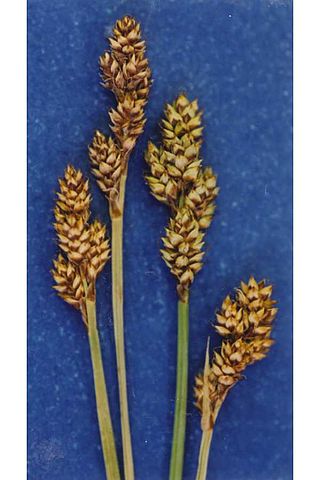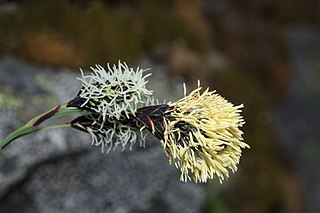This article gives an overview of the mire plant communities in the British National Vegetation Classification system.
Yanal Bog is a 1.6 hectare biological Site of Special Scientific Interest on the southern edge of the North Somerset Levels, just north of the village of Sandford, North Somerset. It was notified as an SSSI in 1988.
Black alpine sedge is a common name for several plants and may refer to:

Carex stricta is a species of sedge known by the common names upright sedge and tussock sedge. The plant grows in moist marshes, forests and alongside bodies of water. It grows up to 2 feet (0.61 m) tall and 2 feet (0.61 m) wide. When the leaves die, they build on top of or around the living plant, making a "tussock". Widely distributed in and east of the Great Plains, it is one of the most common wetland sedges in eastern North America.

Carex abrupta is a species of sedge known by the common name abrupt-beaked sedge or abruptbeak sedge. It is native to the western United States from California to Idaho, where it grows in moist mountain habitat such as meadows.

Carex luzulina is a species of sedge known by the common name woodrush sedge.

Carex pellita is a species of sedge known by the common name woolly sedge.

Carex phaeocephala is a species of sedge known by the common name dunhead sedge.

Carex praeceptorum is a species of sedge known by the common names early sedge and teacher's sedge.

Carex rossii, commonly known as Ross's sedge, is a hardy species of sedge that is often a pioneer species in areas with little or no established vegetation, or in places where disturbance has occurred. Ross's sedge grows in a variety of habitats throughout much of western North America, from Alaska to Ontario, south to New Mexico and California. It flowers in May and June.

Carex spectabilis is a species of sedge known by the common name showy sedge.

Carex pensylvanica is a species of flowering plant in the sedge family commonly called Pennsylvania sedge. Other common names include early sedge, common oak sedge, and yellow sedge.
C. nigricans may refer to:

Elachista alpinella is a moth of the family Elachistidae found in Europe and North America.

Schoenus nigricans is a species of sedge known by the common names black bog-rush and black sedge. It is native to Eurasia, parts of Africa, Australia, and southern North America, including Mexico and the southernmost United States. It grows in many types of wetlands and other moist and alkaline habitat, including marshes, springs, seeps, peat bogs, heath, and alkali flats. This perennial plant grows in low, tight clumps 20 to 70 centimeters tall, with threadlike leaves bearing wide, dark brown ligules. The inflorescence is a small, flattened cluster of dark spikelets. The fruit is an achene coated in a hard, white shell.
Niggerhead is a former name for several things thought to resemble the head of a black person.

Carex bigelowii is a species of sedge known by the common names Bigelow's sedge, Gwanmo sedge, and stiff sedge. It has an Arctic–alpine distribution in Eurasia and North America, and grows up to 50 centimetres (20 in) tall in a variety of habitats.

Carex arctata, known as drooping woodland sedge, is a species of sedge native to eastern North America. It is sometimes called black sedge, compressed sedge, or drooping wood sedge. It occurs from Manitoba to the Maritimes in Canada, south to northwestern North Carolina, and west to Minnesota. Carex arctata grows in bogs, hardwood forests, and spruce forests.

Carex muehlenbergii is a species of flowering plant, it is a type of sedge. It is a grass-like plant in the family Cyperaceae. Its common names include sand sedge, Muhlenberg's sedge.
This page is based on this
Wikipedia article Text is available under the
CC BY-SA 4.0 license; additional terms may apply.
Images, videos and audio are available under their respective licenses.














